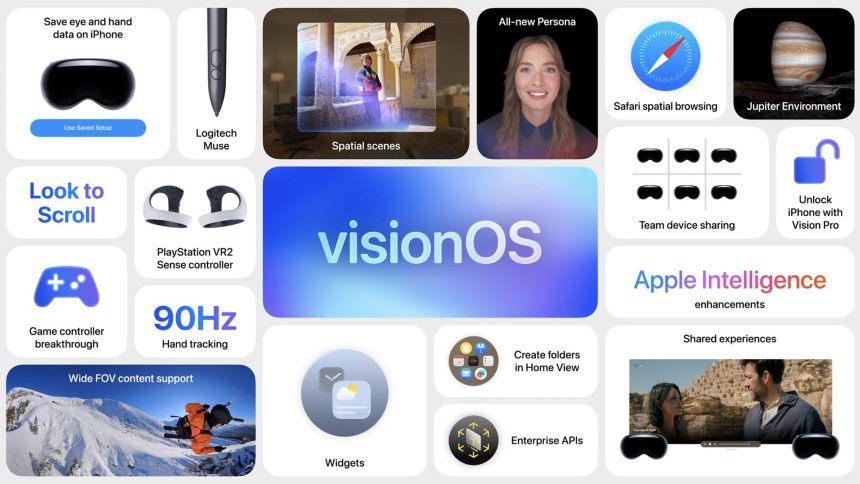Apple has released Visionos 26 for Apple Vision Pro.
Unveiled at WWDC25 and available in beta for developers ever since, Visionos 26 brings PlayStation VR2 Sense Controllers & Logitech Muse Stylus Support, much more realistic persona, spatial widgets, 90Hz hand tracking, volume space scenes, local share play and more to Apple’s headsets.
Everything just arrived at Visionos 26:
PlayStation VR2 Sense Controller
Visionos 26 adds native support for the PlayStation VR2 sense controller. Sony is still expected to start selling separately from the headset, but this hasn’t happened yet.
Support for the PS VR2 sense controller includes 6DOF position tracking, capacitive finger touch detection, and “vibration support.” It is unclear whether precision tactile sensation is supported or whether it is a unique resistance trigger for the PS VR2 sense controller.
Apple has promised that support for the PS VR2 controller will bring “a new class of games” to Vision Pro.
Pickle Pro is the first Apple Vision Pro game to use a PS VR2 controller
Resolution Games’ Pickle Pro is the first announced Apple Vision Pro game to use the PS VR2 Sense controller.
The first major title to support the PS VR2 controller is the resolution game Pickle Pro.
A significant improvement on Persona
In Visionos 26, Persona, a realistic avatar with Apple’s face tracking, has “transformed into something more natural and familiar” thanks to “industry-leading volume rendering and machine learning technology.”
Apple describes these new, more realistic personas as “providing impressive expressiveness and sharpness, a complete side profile view, providing extremely accurate hair, lashes and complexion.” The company has also expanded its Persona eyewear options to include more than 1,000 glass variations.
A new persona is generated in seconds by holding the headset to scan your face.
With Visionos 26 you can pin windows and volumes to physical surfaces like walls, and last during reboots.
Visionos 26 brings widgets to the platform and takes advantage of this pinning and persistence feature. Place these widgets in real space and they reappear every time you wear your headset.
The VisionOS widget is customizable and comes with frame width, color and depth options. Built-in widgets include clocks, weather, music, and photos, and developers can create their own using WidgetKit.
Persistence and surface adjustment capabilities can also be used in VisionOS apps via the new API.
Really 90Hz hand tracking
At the time of release, the Apple Vision Pro’s hand tracking was limited to 30Hz, and in reviews I felt this made me feel dull and unresponsive in the game.
Visionos 2 allows developers to choose to provide hand tracking up to 90Hz, greatly improving responsiveness.

Currently using Visionos 26, Apple says the underlying hand tracking algorithm is actually sampling a 90Hz sensor.
Volume “Spatial Scene”
Since the launch of the Apple Vision Pro, the headset has been able to capture and display 3D photos. Apple called Spatial Photos, and Visionos 2 added the ability to use machine learning to convert 2D images to spatial photos.
Visionos 26 is moving further. We introduce a spatial scene that says, “Utilizing new generative AI algorithms and depth of computation, we create spatial scenes with multiple perspectives, making the user feel like they can lean and look around.”
Spatial scenes can be viewed using the Photos app. This allows you to convert photos into one.
It can also be used on Apple’s Spatial Gallery Platform and Safari web pages, allowing developers to add it to their Visionos apps using the new Spatial Scene API.
Local share play
Previously, we were unable to build a Visionos app that lets multiple Vision Pro headsets automatically display the same objects and interfaces in the same physical space.
Visionos 26 brings this functionality to Vision Pro, leveraging existing Shareplay technology and APIs to enable Vision Pro owners to share their experiences remotely.
Logitech Muse Spatial Stylus
Visionos 26 adds support for Logitech Muse Accessory, the spatial stylus in Apple Vision Pro.
Apple says Logitech Muse “enables accurate input and new ways of doing things, and new ways to interact with collaborative apps such as Spatial Analogue.”
It appears to be very similar to the existing Logitech MX Ink Spatial Stylus on Meta’s Quest Headset.
Spatial browsing in Safari
Visionos 26 brings major new features to Safari with Vision Pro.
The new Safari allows web developers to embed 3D models in web pages, allowing users to drag these 3D models into space.
A new feature called Sapatial Browsing has been built in Safari’s reader mode, providing a “immersive” feeling of browsing web pages where 2D images become spatial scenes.
Native 180° &360° Video Support
Visionos 26 adds native support for traditional 2d 180° and 360° Video is not just Apple’s own 3D Apple Immersive video format.
Apple says this makes it easy to see captured content at an affordable price of 180° and 360° Cameras from companies such as Insta360, GoPro, and Canon.
This system automatically presents footage from the right perspective to make you feel as good as possible so you are truly there.
Home View Folder
Visionos 26 allows you to create app folders on your home screen as much as you can on iOS and iPads.
Previously, there was only one folder that held compatible iPad and iPhone apps.
Unlock your iPhone and answer the call
Visionos 26 and iOS 26 allow you to unlock your iPhone while wearing your Vision Pro.
You can also answer calls that are being called to your iPhone. This will be redirected to Visionos.
Jupiter environment
Visionos 26 adds a new Jupiter home environment.
Apple’s Visionos Jupiter environment is characterized by moving fantastic red spots and dynamic shadows
Developers are beginning to access the Jupiter environment in Apple Vision Pro with Visionos 26 release candidates.

The new environment allows you to place you on Amalthea, one of the closest moons of the gas giant, and speed up the time to see a giant storm “swirl the gas giant as sunlight breaks across its surface.”
A new option in Visionos 26 is called look to Scroll, where Vision Pro owners look near the bottom and scroll through the page.
Game controller breakthrough
Apple Vision Pro always segments and shows your real hands and arms. Since Visionos2, it has shown a feature called keyboard breakthrough.
Visionos 26 does the same for PayStation and Xbox Gamepads and PS VR2 Sense Controllers, bringing game controller breakthroughs.
Apple Intelligence in more countries
Visionos 2.4 brought Apple Intelligence to Vision Pro, but only in English.
Visionos 2.4 brings Apple Intelligence, Spatial Gallery and iPhone integration now
VisionOS 2.4 has been launched, bringing Apple Intelligence to Vision Pro, the spatial gallery app, iPhone app for remote installations, and the new iPhone/iPad-driven guest flow.

Visionos 26 expands this to English in Australia, Canada, India, Singapore and the UK, with French, German, Italian, Japanese, Korean and Spanish.
Basic Model Framework
Visionos 26 allows developers to use Apple Intelligence On-Device LLM (Large Language Models) in their own Visionos apps via the new Foundation Models Framework.
This includes guided generation of structured output and tool calls that allow actions to be performed on the model.
The Foundation Models Framework also enables generative AI even for free apps, as opposed to the current situation where apps need to use paid server-side models.
Team Device Sharing
Visionos 26 allows enterprise companies to look at each employee’s iPhone and save on hand-made calibration and accessibility settings. This configuration is available with shared Apple Vision Pro headsets.
macOS spatial rendering
MacOS 26 allows you to render and stream apps to Visionos 26.
MacOS Spatial Rendering is Apple’s view on PC VR
MacOS 26 renders and streams apps to Apple Vision Pro, allowing Apple’s views on Apple’s PC VR.

“MacOS Spatial Rendering uses the power of your Mac to render and stream immersive content directly to Vision Pro.”








